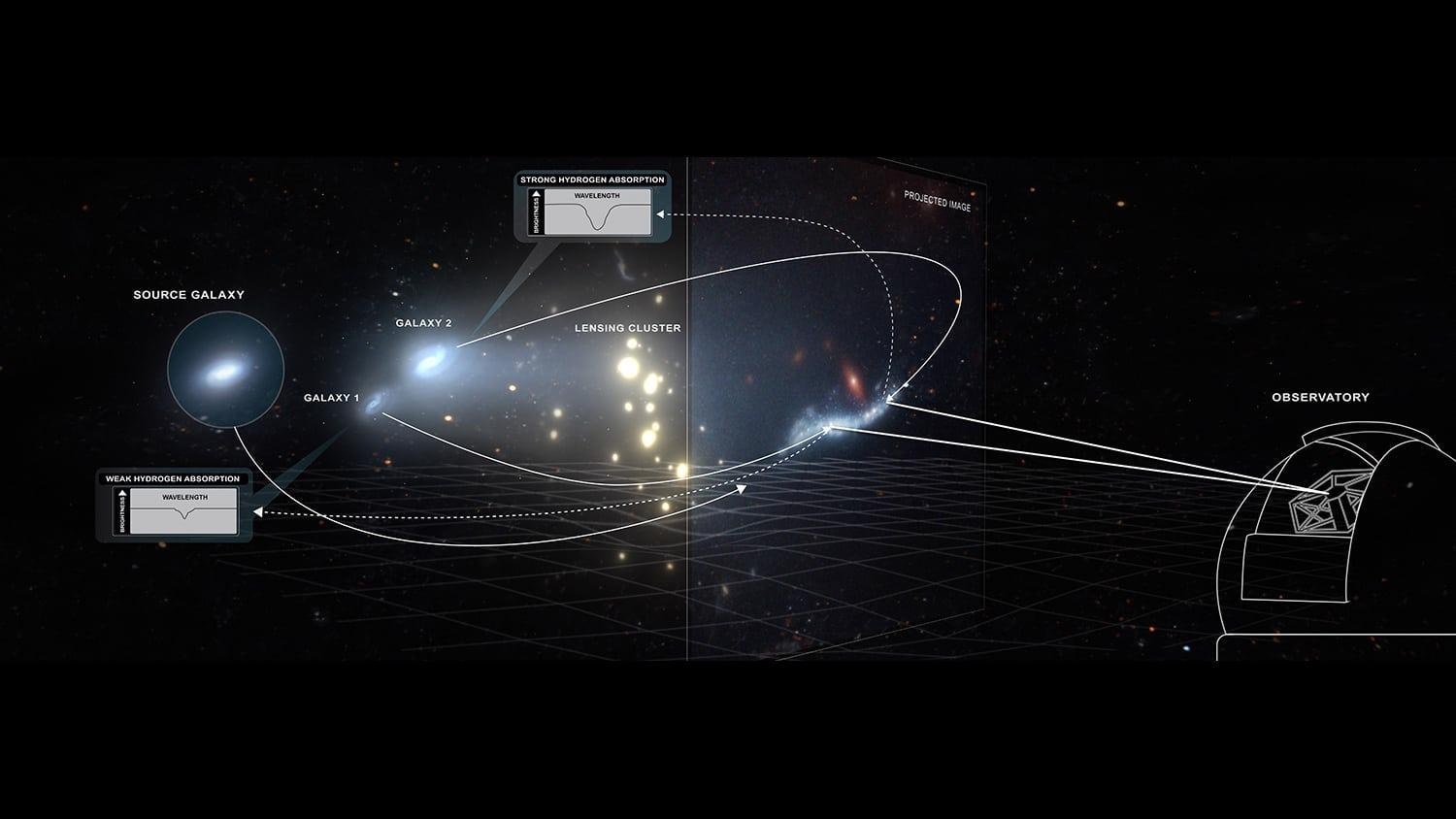Researchers have been able to look deeply into galactic nurseries at the heart of the young universe thanks to a new instrument, a powerful telescope, and a little support from nature.
 An artist’s rendering shows how a cluster of galaxies (lensing cluster) acts as a gravitational lens that magnifies and extends the light from a background galaxy. Image Credit: W. M. Keck Observatory/Adam Makarenko.
An artist’s rendering shows how a cluster of galaxies (lensing cluster) acts as a gravitational lens that magnifies and extends the light from a background galaxy. Image Credit: W. M. Keck Observatory/Adam Makarenko.
The early universe was packed with tremendous clouds of neutral diffuse gas, recognized as Damped Lyman-systems, or DLAs, after the big bang 13.8 billion years ago. As the gases within gradually condensed to fuel the creation of stars and galaxies, these DLAs served as galactic nurseries. Although they can still be seen today, it is difficult task.
DLAs are a key to understanding how galaxies form in the universe, but they are typically difficult to observe since the clouds are too diffuse and don’t emit any light themselves.
Rongmon Bordoloi, Study Corresponding Author and Assistant Professor, Physics, North Carolina State University
Currently, quasars, supermassive black holes that emit light, are used as “backlight” to identify DLA clouds. While this technique allows scientists to narrow down DLA locations, the light from the quasars only behaves as small skewers through a huge cloud, making it difficult to determine their overall size and mass.
Bordoloi and John O’Meara, chief scientist at the W.M. Keck Observatory in Kamuela, Hawaii, used a gravitationally lensed galaxy and integral field spectroscopy to analyze two DLAs—and the host galaxies inside it—that established around 11 billion years ago, not long after the big bang.
Gravitationally lensed galaxies refers to galaxies that appear stretched and brightened. This is because there is a gravitationally massive structure in front of the galaxy that bends the light coming from it as it travels toward us. Therefore, we end up looking at an extended version of the object – it is like using a cosmic telescope that increases magnification and gives us better visualization.
Rongmon Bordoloi, Study Corresponding Author and Assistant Professor, Physics, North Carolina State University
“The advantage to this is twofold: One, the background object is extended across the sky and bright, so it is easy to take spectrum readings on different parts of the object. Two, because lensing extends the object, you can probe very small scales. For example, if the object is one light year across, we can study small bits in very high fidelity,” Bordoloi added.
Astrophysicists can “see” elements in deep space that are not visible to the human eye, like diffuse gaseous DLAs and the potential galaxies inside them, using spectrum readings. Generally, accumulating the measurements is a time-consuming and laborious process. The team overcame this problem by using the Keck Cosmic Web Imager to function integral field spectroscopy.
Integral field spectroscopy enabled the researchers to acquire a spectrum at each pixel on the part of the sky they were interested in, making spectroscopy of a large object in the sky very effective.
This breakthrough, combined with the elongated and brightened gravitationally lensed galaxy, enabled the group to accurately trace the diffuse DLA gas in the sky. The researcher was able to identify not only the size of the two DLAs, but also that they both enclosed host galaxies using this technique.
I’ve waited most of my career for this combination: a telescope and instrument powerful enough, and nature giving us a bit of lucky alignments to study not one but two DLAs in a rich new way. It’s great to see the science come to fruition.
John O’Meara, Chief Scientist, W.M. Keck Observatory
However, DLAs are massive, taking up more than two-thirds the size of the Milky Way galaxy now, with diameters larger than 17.4 kiloparsecs. In contrast, a typical galaxy 13 billion years ago would have had a diameter of fewer than 5 kiloparsecs. A parsec is 3.26 light-years, and a kiloparsec is 1,000 parsecs, so the light would commute across each DLA in about 56,723 years.
“But to me, the most amazing thing about the DLAs we observed is that they aren’t unique—they seem to have similarities in structure, host galaxies were detected in both, and their masses indicate that they contain enough fuel for the next generation of star formation,” Bordoloi adds. “With this new technology at our disposal, we are going to be able to dig deeper into how stars formed in the early universe.”
Journal Reference:
Bordoloi, R., et al. (2022) Resolving the H I in damped Lyman α systems that power star formation. Nature. doi.org/10.1038/s41586-022-04616-1.